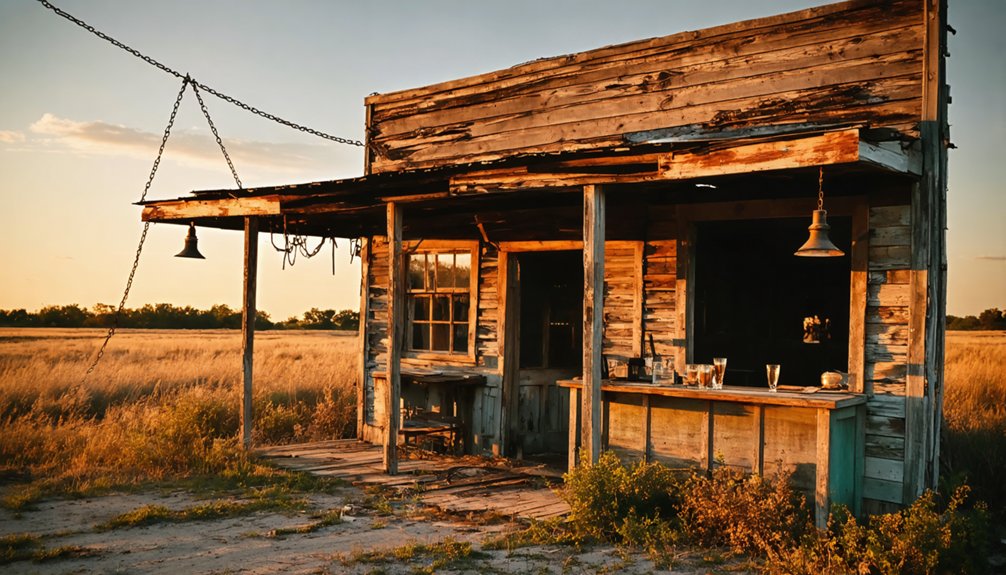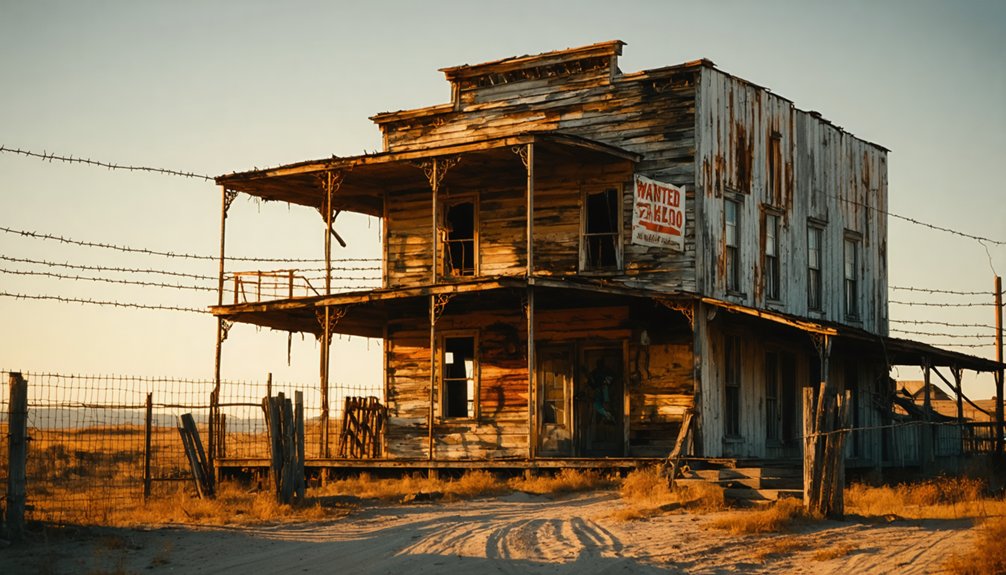Colorado’s abandoned mining camps offer windows into the state’s rich Old West history, from the 1859 Gold Rush through the silver boom and bust cycles. You’ll find photogenic ruins like Crystal Mill alongside cautionary tales like Gilman, a toxic Superfund site. Many remote camps require 4×4 vehicles to access, while others have become tourist destinations. These ghost towns stand as monuments to fortune’s fickleness and nature’s reclamation of human enterprise.
Key Takeaways
- Colorado’s 1859 Gold Rush triggered a mining boom that left hundreds of ghost towns scattered throughout the Rocky Mountains.
- Many abandoned mining camps like Crystal City require 4×4 vehicles due to their remote, high-altitude locations.
- Ghost towns such as Gilman demonstrate mining’s environmental impact, with some sites designated as Superfund cleanup areas.
- Former mining communities like Leadville and Aspen experienced revival through tourism and historical preservation efforts.
- Exploring abandoned mining camps provides firsthand glimpses into boom-and-bust economic cycles that shaped Colorado’s development.
The Rise and Fall of Colorado’s Mining Frontier
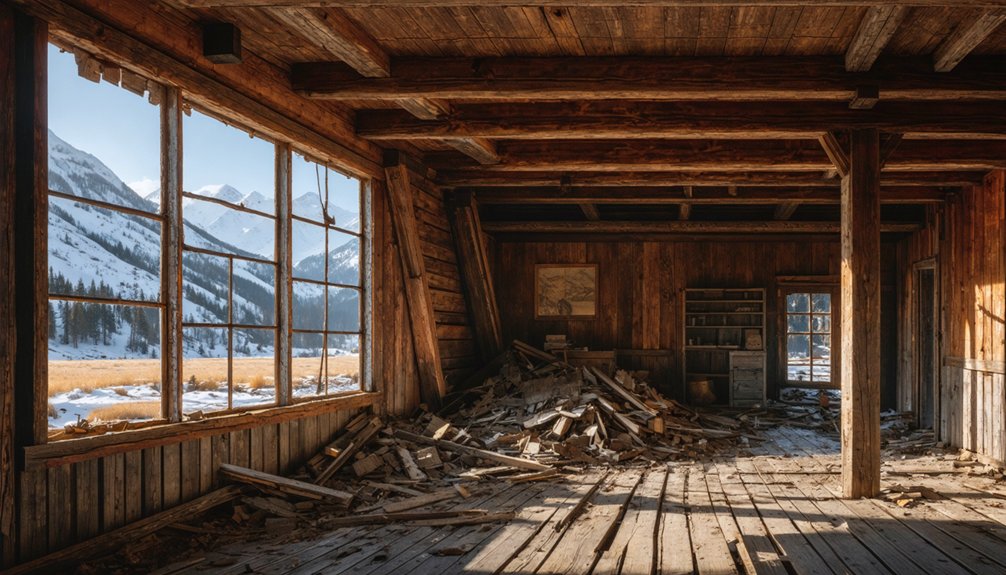
While the Pikes Peak Gold Rush of 1859 serves as the formal catalyst for Colorado’s mining frontier, the region’s transformation began a year earlier when gold discoveries along the South Platte River established Montana City as an early migration hub.
You’d have witnessed spectacular growth between 1860-1863 as placer mining techniques flourished and prospectors like Charles Baker pushed into the San Juan Mountains.
The frontier’s trajectory wasn’t linear. As you explore abandoned camps today, you’ll notice evidence of economic challenges that shaped their fates. The Brunot Treaty (1873) opened four million acres in the San Juans to miners, triggering a massive influx of prospectors into previously restricted territories.
Surface gold depletion forced miners to develop shaft mining and complex ore processing by the 1860s. In 1860, pioneers began producing their own gold coins with the Pikes Peak emblem to avoid costly shipments east. The 1893 repeal of the Sherman Silver Purchase Act devastated communities built on silver wealth.
While many sites were abandoned as deposits dwindled, others like Cripple Creek endured, continuing Colorado’s mining legacy.
Ghost Towns Frozen in Time: Crystal City and Tincup
Colorado’s mining frontier left behind remarkable architectural footprints, with few sites as evocative as Crystal City and Tincup. Founded in 1880 as a silver mining camp, Crystal City flourished briefly before the 1893 silver crash decimated its economy. At its peak, this remote Gunnison County settlement housed 600 residents, supported by seven silver mines and various businesses.
Today, ghost town exploration in Crystal City offers a pristine window into mining life. The Crystal Mill, built in 1893 to power air compressors, stands as Colorado’s most photographed historical structure. The town had a vibrant community with The Silver Lance newspaper and numerous saloons during its heyday. Visitors should remember that the area is only accessible seasonally, as the rough roads are impassable during winter months.
You’ll find the town accessible only by a challenging six-mile 4×4 road from Marble. Recent preservation efforts include restricting river access below the mill due to vandalism—a reminder that our freedom to explore comes with responsibility toward these irreplaceable historical treasures.
Environmental Legacy and Hazardous Beauty of Gilman
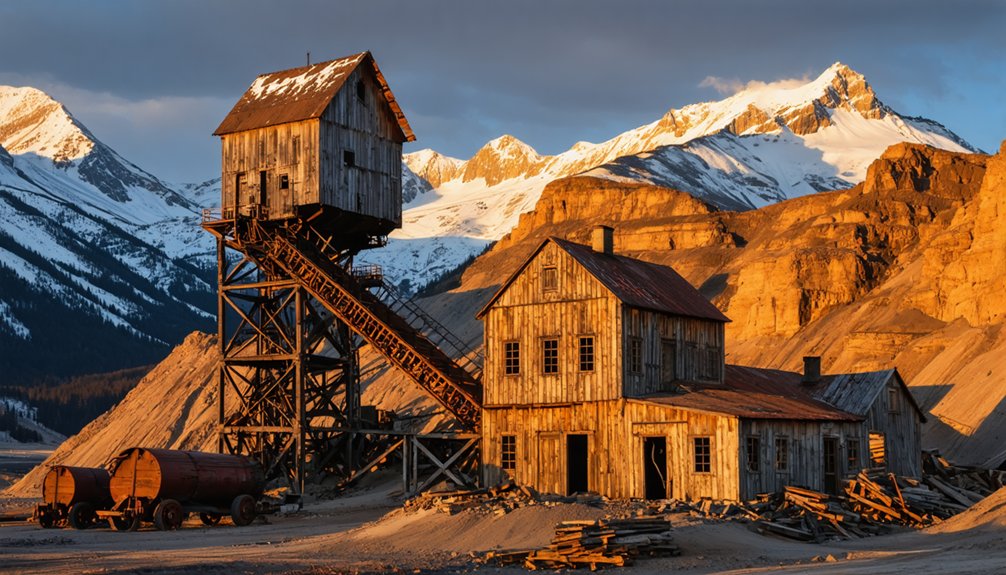
When you approach the cliffs of Gilman today, you’ll witness the haunting paradox of a town that produced $12 million worth of ore annually now abandoned due to the very minerals that created its wealth.
The EPA’s 1985 mandatory evacuation and subsequent Superfund designation reveal how the 8 million tons of mine waste transformed this once-thriving community into a toxic no-man’s land.
Despite extensive cleanup efforts throughout the 1990s that officially concluded in 2000, the ghost town remains permanently uninhabitable—a cautionary monument to mining’s environmental costs. The town that once flourished during mining operations stands as a stark reminder of industry’s environmental impact.
Toxic Mining Legacy
Beneath the haunting beauty of Gilman’s abandoned structures lies a toxic legacy that has permanently altered the surrounding landscape.
You’re witnessing the aftermath of decades of mining that released lead, zinc, cadmium, arsenic, and manganese into the environment. This contamination forced the EPA to intervene in 1984, evacuating residents and sealing off the town. Following the evacuation, families were forced to abandon their homes and possessions as the town transformed from a vibrant community to a silent ghost town.
The Superfund designation in 1986 marked the beginning of extensive environmental restoration efforts.
While you can’t legally enter Gilman today, the remediation work has yielded results. The site once supported a thriving community with amenities and businesses including a school, grocery store, bowling alley, and infirmary. A water treatment plant now processes 140 million gallons annually, removing 175 pounds of zinc daily.
Despite this progress, toxic waste remains, creating a paradoxical scene where deer now roam freely through contaminated grounds—nature reclaiming what humans poisoned and abandoned.
Visible Yet Untouchable
Perched dramatically on a 600-foot cliff above the Eagle River, Gilman presents a tantalizing paradox to travelers along Highway 24—hauntingly visible yet legally untouchable.
From designated pull-offs, you’ll witness a tableau of industrial decay against stunning mountain backdrops: crumbling structures, rusting vehicles, and graffiti-covered walls that have become unintentional canvases for historical preservation.
The town’s artifacts—company documents in desk drawers, names on chalkboards from the final shift—remain frozen in time, creating an irresistible draw for urban exploration enthusiasts.
Yet strict access restrictions protect you from unstable structures and toxic remnants of mining operations.
This ghost town’s visibility combined with its forbidden status amplifies its mystique, allowing you to experience a slice of Colorado’s mining heritage from afar while respecting the site’s environmental hazards.
During its heyday, the town produced an impressive 10 million tons of precious metals including silver, gold, copper, zinc, and lead.
The extensive EPA Superfund site designation in 1986 highlights the severe environmental contamination that persists beneath Gilman’s picturesque exterior.
EPA Superfund Intervention
The environmental paradox of Gilman emerged in 1986 when the EPA designated the abandoned mining town and surrounding Eagle Mine area as a Superfund site—a decisive intervention that acknowledged both the area’s historical significance and its toxic legacy.
You’ll find that behind this EPA intervention lay an ecological nightmare: 8 million tons of mine waste contaminating the landscape across 235 acres.
CBS Operations inherited the cleanup responsibility after corporate acquisitions traced back to New Jersey Zinc Company’s century-long operations.
The Superfund designation triggered extensive remediation: waste consolidation, soil capping, and construction of a water treatment plant addressing the 100-200 gallons of contaminated seepage flowing every minute.
Despite declaring the cleanup “substantially complete” by 2000, orange stains still mark where toxins escape—visible reminders of an industrial past that can’t be completely erased.
From Boom to Bust: Economic Cycles of Mountain Mining

You’ll find Colorado’s economic history intricately tied to silver’s dramatic boom-and-bust cycle, from the 1879 Leadville rush that generated $82 million to the devastating 1893 crash that bankrupted investors and miners alike.
While silver mining eventually waned, coal maintained steadier production, becoming an economic stabilizer that outlasted precious metals’ volatility.
By 1978, the state’s mining industry had grown to become Colorado’s fourth largest industry, generating approximately $1.4 billion in mineral production value.
Silver’s Rise and Fall
Silver’s dramatic saga in Colorado’s mining history represents one of the most profound boom-and-bust cycles in American economic development.
When you explore ghost towns like Leadville and Aspen today, you’re walking through the remains of an economic revival that transformed the state beginning in 1879.
The silver mining industry’s meteoric rise followed discoveries in Summit County (1864) and culminated with Leadville’s rich deposits yielding $82 million.
You’ll find evidence of the infrastructure that followed—railroads and innovative ore processing technologies that supported thriving communities.
But when you visit these abandoned camps, you’re also witnessing the aftermath of the 1893 Sherman Silver Purchase Act repeal that devastated Colorado’s economy.
Mining towns emptied overnight, leaving behind the skeletal structures that now stand as monuments to fortune’s fickleness.
Coal’s Sustained Impact
Coal’s economic cycles, unlike silver’s rapid collapse, etched deeper and more enduring patterns into Colorado’s landscape and communities.
As you explore abandoned coal camps, you’ll witness the remnants of an industry that generated $675 million in 2015 despite its ongoing contraction.
When you visit these sites, remember that each million tons of coal production once attracted 209 new residents, creating entire communities that thrived for decades before fading.
The economic impacts stretched across generations—coal mining’s boom periods lasted roughly 20 years before the inevitable bust followed, leaving ghost towns in their wake.
Unlike precious metals’ dramatic crashes, coal’s decline was often gradual, allowing some communities time to diversify.
The abandoned company stores and miners’ quarters you’ll find tell stories of economic volatility that shaped Colorado’s development.
Post-Mining Economic Shifts
When the final pickaxes fell silent in once-thriving mining districts, communities throughout Colorado faced stark economic reckonings that transformed the state’s mountain regions.
You’ll discover how Leadville’s dominance—producing nearly half of Colorado’s metals by 1887—collapsed when carbonate ore became scarce and silver prices plummeted.
The mining landscape shifted dramatically from individual prospectors to corporate consolidation by the 1890s. This change created significant labor challenges as companies reduced wages during downturns, triggering strikes that required militia intervention.
Meanwhile, communities experienced population instability as workers migrated between boom-and-bust cycles.
Economic diversification became essential for survival. As gold deposits in Cripple Creek required increasingly complex extraction methods, the financial barriers grew too steep for independent miners, permanently altering Colorado’s economic foundation from individualistic opportunity to corporate dependency.
Hidden Gems: Accessing Remote Mining Camp Ruins
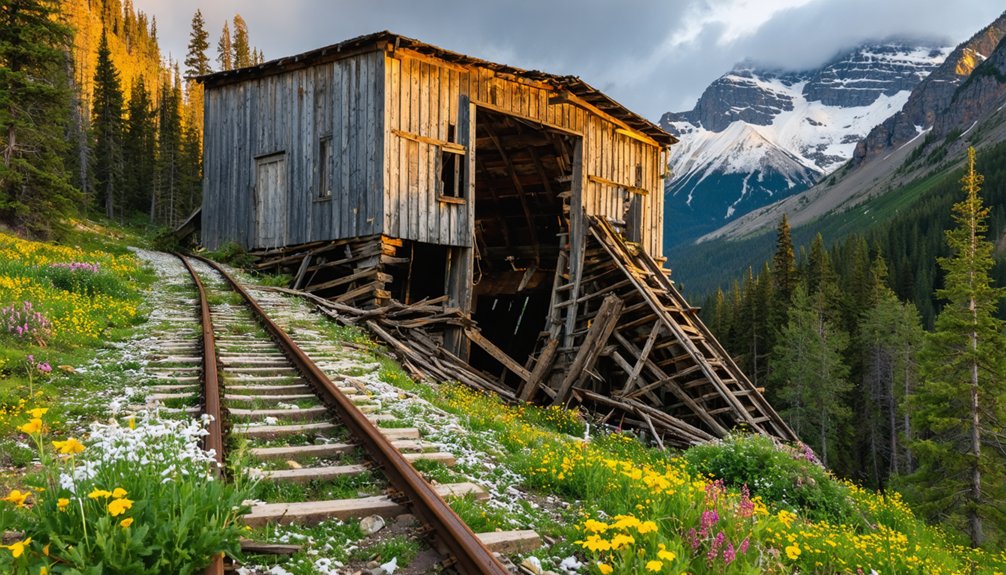
Beyond the well-trodden tourist paths of Colorado lie some of the state’s most enchanting historical treasures—remote mining camps that once bustled with activity but now stand frozen in time.
These historical sites demand determination for remote exploration, with most requiring high-clearance or 4×4 vehicles to navigate rugged mountain roads.
You’ll find Animas Forks perched at 11,200 feet along the Alpine Loop 4×4 byway, while Carson City sits even higher at 12,000 feet atop the Continental Divide.
For those without off-road vehicles, Ghost Town Hollow offers accessibility via a 1.4-mile hiking trail along Pikes Peak Highway.
Summitville presents a more moderate option, reached by 25 miles of graded gravel road from Del Norte—a compromise between accessibility and the authenticity of vehicle requirements that defines these remote historical sanctuaries.
Preservation Efforts and Tourism in Historic Mining Districts
While discovering remote mining ruins offers a glimpse into Colorado’s past, preserving these fragile historical sites requires coordinated effort across multiple organizations.
Preservation strategies involve partnerships between entities like Colorado Preservation, Inc. and local communities, with funding from grants and the Abandoned Mine Reclamation Program’s $2 million annual budget.
You’ll find successful community engagement takes many forms:
- Conservation easements protecting both historical and environmental aspects
- Categorization of sites as “interpretive” or “stewardship” to focus maintenance efforts
- Local commissions partnering with towns to secure legal protection
- Adaptive reuse of structures maintaining district integrity
- Educational programs and interpretive trails enhancing public understanding
Tourism infrastructure like the Gold Belt Tour Scenic Byway and museums in Leadville and Cripple Creek transforms preservation work into economic opportunity while enabling visitors to connect with Colorado’s mining heritage.
Frequently Asked Questions
Were Women and Minorities Present in These Mining Communities?
Yes, you’ll find women helped transform mining camps by establishing gender roles that civilized community dynamics, while minorities from diverse backgrounds faced discrimination yet contributed notably to these evolving settlements.
What Indigenous Tribes Occupied These Territories Before Mining Began?
You’re walking on land with deep tribal history once occupied by Ute, Arapaho, Cheyenne, Shoshone, Apache, and Comanche nations, whose cultural significance was disrupted by mining’s territorial encroachment.
How Did Mining Camps Handle Law Enforcement and Criminal Activity?
You’d find mining camps governed themselves through elected officials who enforced mining regulations and community-created rules. When formal law failed, vigilante justice emerged—with juries deciding punishments from fines to banishment for serious offenders.
What Foods Were Commonly Consumed in Isolated Mining Settlements?
Beans, bacon, and biscuits formed your fundamental fare. You’d rely on preserved foods like canned goods, salt pork, and dried meats, with campfire cooking transforming these simple staples into sustaining meals.
Did Any Paranormal or Ghost Stories Originate From These Abandoned Towns?
You’ll find rich paranormal traditions in these ghost towns. Gilman features reports of phantom footsteps and shadow figures, while haunted locations like Animas Forks host spectral miners eternally working abandoned shafts.
References
- https://gunnisoncrestedbutte.com/blog/hike-to-colorados-abandoned-mining-camps/
- https://www.legendsofamerica.com/co-ghosttowns/
- https://www.coloradolifemagazine.com/printpage/post/index/id/172
- https://www.motortrend.com/features/1812-adventure-exploring-the-abandoned-mining-camps-of-colorado
- https://www.uchealth.org/today/ghost-towns-abound-in-colorado/
- https://www.durango.com/colorado-ghost-towns/
- https://ghosttownmuseum.com/our-story/
- https://www.colorado.com/articles/colorado-ghost-towns
- https://www.legendsofamerica.com/early-southwestern-colorado-mining/
- https://www.uncovercolorado.com/colorado-mining-history-timeline/

